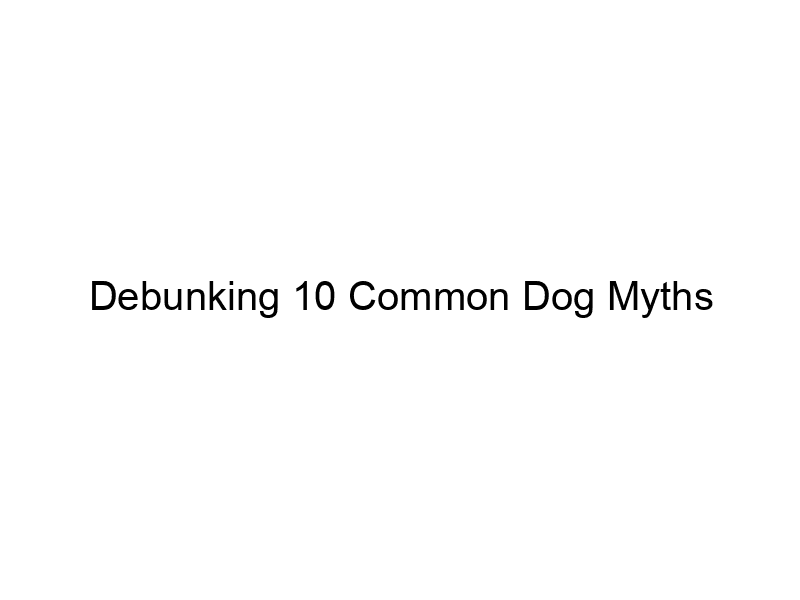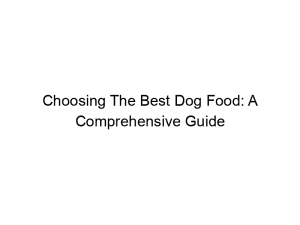Are you a dog lover? Do you rely on what you’ve heard from friends, family, or even online forums when it comes to caring for your canine companion? Many widely-held beliefs about dog behavior and health are actually myths. Understanding these misconceptions is crucial for providing the best possible care for your furry friend. This article will debunk 10 Dog Myths You Should Stop Believing Right Now, providing evidence-based information to help you become a more informed and responsible dog owner. We’ll cover everything from feeding habits and training techniques to grooming practices and common health concerns. Get ready to improve your dog’s well-being by learning the truth behind these pervasive myths!
While regular exercise is essential for a dog’s physical and mental health, the required amount
varies drastically depending on breed, age, and individual energy levels. A high-energy breed like a Border Collie will require significantly more exercise than a low-energy breed like a Cavalier King Charles Spaniel. A short, brisk walk can be just as beneficial as a long, leisurely stroll for some dogs. Focus on providing stimulating activities, such as fetch, puzzle toys, or training sessions, to supplement walks and ensure your dog gets enough mental and physical stimulation. Over-exercising, especially in puppies or senior dogs, can lead to injuries.
Myth 2: Dogs Should Only Eat Dry Kibble
The Importance of a Balanced Diet
Many believe that dry kibble is the only suitable food for dogs. This is untrue. A balanced diet can include wet food, raw food (with caution and proper preparation), and even home-cooked meals, provided they are nutritionally complete and balanced. Consulting with a veterinarian or a veterinary nutritionist is crucial to determine the best dietary approach for your dog’s specific needs and age. Consider factors like breed, allergies, and any underlying health conditions when making dietary choices. The key is to provide a diet that meets your dog’s nutritional requirements, not to adhere rigidly to a specific food type.
Myth 3: A Dog’s Yawning Means It’s Bored or Tired
Understanding Canine Communication
While yawning can be a sign of tiredness or boredom, it also serves other purposes in canine communication. Yawning can be a sign of stress or anxiety in dogs. Just like humans, dogs may yawn when they are feeling nervous or uncomfortable in a situation. Moreover, contagious yawning is a real phenomenon in dogs, meaning they might yawn in response to seeing their owner or another dog yawn. Observing the dog’s overall behavior and body language provides more context than relying solely on yawning as an indicator of their emotional state.
Myth 4: Dogs Only Need to Drink Water
Hydration Beyond Water
Dogs require hydration through various sources, not just water. Wet food and fruits (like watermelon – in moderation!) contribute to their daily fluid intake. However, always ensure access to fresh, clean water throughout the day. Dehydration can quickly become a serious health issue for dogs, leading to various complications. The amount of water a dog needs depends on factors such as size, activity level, climate, and diet. Monitor your dog’s water consumption and consult a vet if you notice any unusual changes.
Myth 5: All Dogs Shed Equally
Understanding Coat Types and Shedding Patterns
Dogs shed, but the amount and frequency vary significantly depending on their breed and coat type. Some breeds, like Huskies, are notorious for their heavy shedding, while others, like Poodles (with proper grooming), shed minimally. Regular brushing is crucial for all dogs, but especially for heavy shedders, to manage shedding and prevent matting. A good quality brush suitable for your dog’s coat type will be vital to maintain their coat’s health and manage loose hair. Understand your dog’s breed characteristics to better manage their shedding habits.
Myth 6: “Alpha Roll” is an Effective Training Technique
Dominance vs. Fear-Based Training
The concept of “alpha rolling,” which involves pinning a dog to the ground to assert dominance, is outdated and harmful. It’s based on outdated dominance theories and can cause fear, anxiety, and aggression in dogs. Positive reinforcement training methods, which focus on rewarding desired behaviors, are far more effective and humane. These methods build trust and a positive relationship between the dog and its owner, leading to better obedience and a happier dog. Consult a certified professional dog trainer for guidance on effective training techniques.
Myth 7: A Dog’s Tail Wagging Always Means Happiness
Decoding Tail Wags
While a wagging tail often signifies happiness, it can also indicate other emotions, including fear or anxiety. The speed, height, and stiffness of the wag, combined with other body language cues (ears, posture, lip movements), provide a fuller picture of the dog’s emotional state. A stiff, high wag might suggest aggression, while a low, slow wag can signal fear or insecurity. Pay close attention to the entire picture, not just the tail wag, to accurately interpret your dog’s feelings.
Myth 8: You Can Only Train Puppies
Training at Any Age
While puppies are more receptive to training due to their plasticity, older dogs can also learn and adapt. Training should be a lifelong process, adapting to the dog’s age and abilities. Older dogs might learn at a slower pace, requiring more patience and positive reinforcement. Focus on building positive associations and making training fun and engaging for your dog, regardless of their age. Senior dogs may require modified exercises and shorter training sessions.
Myth 9: Dogs Eat Grass Because They’re Sick
Reasons Behind Grass Eating
Dogs sometimes eat grass for various reasons, and it’s not always an indication of illness. Some dogs may eat grass to relieve an upset stomach or to induce vomiting if they’ve ingested something they shouldn’t have. However, others might eat it out of boredom, habit, or simply because they enjoy the taste. Observing your dog’s overall behavior will help distinguish between normal grass eating and a potential health concern. If there are other symptoms, consult your veterinarian immediately.
Myth 10: All Dogs Need to Be Bathed Frequently
Grooming Practices and Coat Types
Frequent bathing can strip a dog’s coat of its natural oils, leading to dryness and skin problems. How often you bathe your dog depends on their breed, coat type, and lifestyle. Some dogs need bathing only a few times a year, while others might require more frequent baths, perhaps every few months. Regular brushing is more important than frequent bathing for most dogs, helping to remove dirt, debris, and loose hair. Consult your veterinarian or a professional groomer for specific grooming recommendations for your dog’s breed and coat.
Frequently Asked Questions
What are some signs of a dog being unhappy?
Signs of unhappiness in dogs can vary greatly, but common indicators include excessive whining or barking, changes in appetite (eating less or more than usual), lethargy or lack of energy, destructive behaviors (chewing furniture, digging), hiding, changes in sleep patterns, and excessive licking or scratching.
How often should I brush my dog’s teeth?
Ideally, you should brush your dog’s teeth daily to maintain optimal oral hygiene. This helps prevent dental disease, gum inflammation, and bad breath. Even brushing a few times a week is better than nothing. Use a pet-specific toothpaste and toothbrush.
My dog is constantly shedding, is this normal?
The level of shedding depends heavily on breed and season. While some shedding is normal, excessive shedding might indicate an underlying health issue such as allergies, parasites, or hormonal imbalances. Consult your veterinarian if you are concerned.
How can I tell if my dog is stressed?
Stress in dogs manifests in various ways, including panting, yawning, lip licking, changes in posture (hunched back, tucked tail), avoidance behaviors, increased anxiety, changes in appetite, and destructive behavior. If you notice any of these signs, try to identify the stressor and take measures to alleviate it. If it continues, consult a veterinarian or a professional dog behaviorist.
Final Thoughts
Understanding these 10 dog myths and replacing them with factual information empowers you to provide better care for your canine companion. Remember, responsible dog ownership requires continuous learning and adaptation based on your dog’s individual needs. By dispelling these common misconceptions and adopting evidence-based practices, you can build a stronger, healthier, and happier relationship with your furry friend. Don’t hesitate to consult with your veterinarian or a certified professional dog trainer for any specific concerns or questions about your dog’s health, behavior, or training. Providing your dog with the best possible care is an investment in a long and fulfilling companionship.




